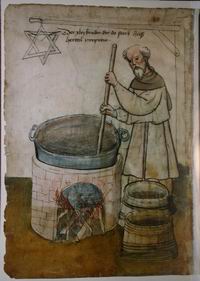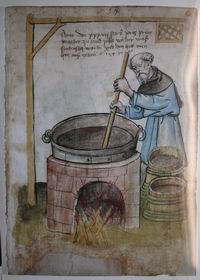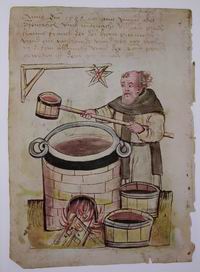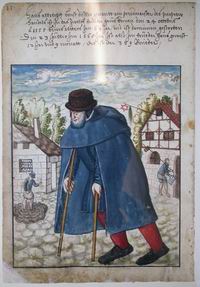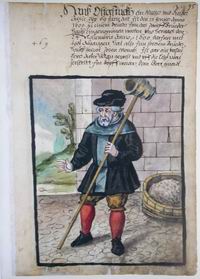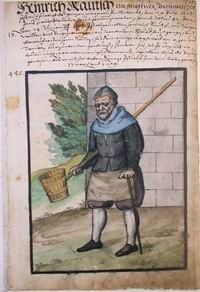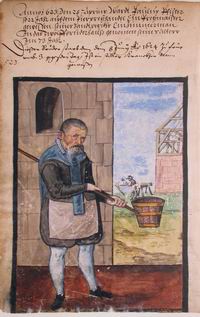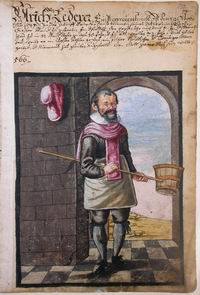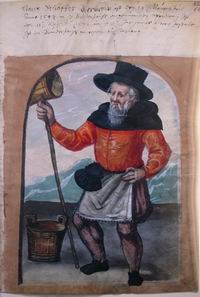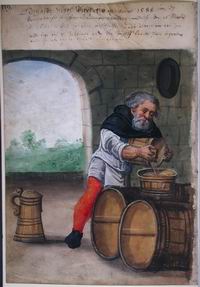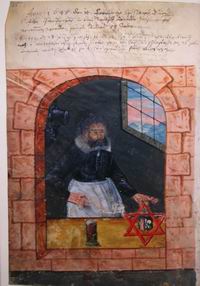Historical depictions, guild signs and symbols of the brewing and malting handcraft
Depiction of brewers
According to todays point of research the oldest german craft depictions [43] of brewers are from the housebook of the brother's endowment of the family Mendel. This family had become wealthy through trade in Nürnberg and commited many acts of charity for the poor. In 1388 Konrad Mendel senior foundet the endowment, in which 12 old, sick but not impaired men, who have the Nürnberg citizenship and could not provide for themselves through work (12 alte, kranke, aber nicht bettlägerige Männer, welche das Nürnberger Bürgerrecht besaßen und sich mit eigener Arbeit nicht mehr ernähren konnten [44] ) should live according to the example given by the apostles and be taken care of. However, the members of the endowment were no monks, as often stated in combination with this picture. Quite the opposite: As the family Mendel was member of city council and hence very powerful, they had more insight into the clerical structure of might and wealth than most other people of that time. As the church in that era often did not behave very charitable and might and material values were not seldomly more important than faith, the Mendel had developped a certain distance towards the clerus. The house rules of the endowment were almost anti churchly, specifically clerical people were not allowed to become members [45] . This institution can therefore by no means be compared with a monastery.
The Mendel endowment set an example for many following instituions in various cities, amongst others Deggendorf, Salzburg und Passau [46] , i.e. the "twelve brother's endowment" of the family Landauer mentioned in one of the next chapters of this thesis.
3.1 House book of Mendel
Around 1425 the "image hand writing" (in german: Bilderhandschrift), also referred to as house book, was commenced at the instigation of Marqurd Mendel. He was grandson of Konrad Mendel sr. and also curator in the endowment. The book has 3 volumes, of which especially 1 and 2 (until 17th century) are interesting in regards to handcraft. The members of the endowment are depicted at work with the then common tools. From the 17th century onwards, the writers (unfortunately) switched to mere portraits.
The most famous and within the house book oldest depiction of a brewer is Pyprew (old german word for brewer) Herttel from 1425 [47] .
Abb. 7: Herttel
Pyrprew,
Mendel Band I (1425), Seite 20v
The text on the picture states: "The 46th brother, who died here, was named Herttel Pyrprew" ("Der XLVI Bruder, der do starb, hieß Herttel Pyrprew"). One can see the brewing kettle with two rings attached to the sides plus two wooden vats. Above the brewer on a stick the hexagram [48] . Herttel appears to be stirring the kettle over open fire.
Another brewer depiction can be found in 1437:
Abb. 8: Jorg
Prewmaister,
Mendel Band I (1437), Seite 60
Text states: "In the year of the lord 37 Jorg Prewmaister, the 124th brother died in Jobs due to leprasy" (Anno domini XXXVII starb Jorg Prewmaister zu sand Jobs [49] , wan der waß sundersich [50] worden und den hett man zinaußgetan, der 124 bruder).
The apparent alikeness between image 7 and 8 are typical for the first writer of the house book, who made the first 120 pictures [51] . All other craftsmen drawn by this artist bear the same facial features, as can be shown in the following image::
Abb. 9: Darstellung
eines Webers,
Mendel Band I, 15. Jh.
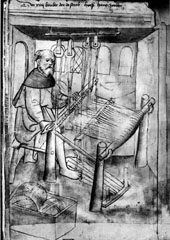
In addition, the first 97 brothers were drawn posthumously (after death) and hence the artist did not know them personally. [52] These are therefore not real depictions of the brewers (like foto's we know today).
Image 8 shows, like image 7, a brewing kettle with rings attached to the side and two wooden vats. The symbol above the brewer this time looks like a grid. As Herttel, Jorg appears to be stirring in the kettle over open fire.
The next depiction of a beer related profession is from 1506.
Abb. 10: Hans
Franck, Biermesser,
Mendel Band I (1506), Seite 125v
Hans Franck was beer measurer and hence a city employee. The beer measurers determined malt and beer amounts for tax purposes [53] . There is quite a similarity with image 7 and 8, but the facial features are different, as it is a different artist [54] . Again the rings, the vats and the poorly drawn hexagram (almost looks like a pentagram) can be seen [55] . The beer tumbler is a new tool.
Another image can be found in 1560
Abb. 11: Hans,
genannt Distler, Albrecht,
Mendel Band II (1560), Seite 24v
Distler Albrecht is not - like the others - at work, but standing outside in front of two buildings. In the background on a pole on can see the - for the first time red - hexagram and an bush or branch, a specialty which will be further explained in chapter 4. The other two depicted people are quite interesting. The one on the left appears to be sowing, while the one on the right, equipped with mug and beer tumbler, walks into the building. It is persieveable that hence the left building is the malt house and the right building is the brewery. This is affirmed by the two chimneys, as fire is necessary for both production steps. This is the first image in which the brewer is depicted without tools and that will become standard from the 17th century onwards.
The images of the following years after Hans Distler are all quite similar
Abb. 12: Hans
Osterstückh,
Melzer,
Mendel Band II (1600), Seite 66
Abb. 13: Heinrich
Kautsch,
Preumeister,
Mendel Band II (1607), Seite 75
Abb. 14: Paulus
Pfister,
Mendel Band II (1624), Seite 98v
Abb. 15: Ulrich
Lederer,
Mendel Band II (1647), Seite 126
Brewers are shown "posing" with beer tumbler. A specialty
is in image 12: Behind Hans Osterstückh one can see a wooden vat with a
dark mass. As Osterstückh is described as maltster, it is persievable,
that this mass is malt, green malt or steeped grain.
3.2 House book of the Landauer
One century after the family Mendel, the family Landauer founded another twelve brother endowment in Nürnberg [56] . This foundation also has a house book with many handcraft images. As in the Mendel house book from the 17th century onwards only portraits are inlcuded without tool. Before that time, there are three interesting pictures of brewers.
Abb. 16: Hans
Schäffer,
Landauer Band I (1596), Seite 64
Hans Schäffer is depicted with the beer tumbler and a bucket. Symbols or emblems can not be seen.
Abb. 17: Linhardt
Sigel,
Landauer Band I (1610), Seite 60v
The image of Linhardt Sigel shows something new: The filling of barrels. Left a wooden mug.
Abb. 18: Jacob
Linckh,
Landauer Band I (1659), Seite 118v
Jacob Linckh is drawn without tools, but with a hexagram in red color. Inside the star an symbol, maybe the family emblem.
3.3 Conclusion of the images
If one looks at alle beer related depiction in both house books, one can notice that all brewers with kettles also have a symbol on a pole above. At the same time all kettles have rings attached, probably to be movable.
Two specialties of Nürnberg play in role in this context: On the one hand there were no guilds as already mentioned [57] , on the other hand the brewers of Nürnberg did not regard themselves as craftsmen. They felt as tradesmen and up until the 15th century did not even have to know how to brew beer [58] . Brewing was done by city employed brewmaster and their menials, which gave the city council a better control over beer production and - most importantly - taxation of beer. The system was completed by the curatorial beer measurers [59] . A similiar city supervision was also common in Freiberg [60] .
The brewers oath had to be spoken by everyone who preuwent und mulcent oder mit den kessel umbegent [61] , e.g. those who brew, malt or walk around with the kettle.
All this indicates, that brewmasters and beer measurers walked from house to house with the beer kettle to brew beer for the house owner. To indicate the availability of beer to the citizens, a tapping sign was put on a pole outside the brewing place [62] .
The office of city brewmaster disappears in later years [63] and consequently no more brewing kettles with attached rings can be found in the house books. The depictions in the book of the Landauer support this conclusion, too, as there are no "ring kettles" either. Another reason probably is the increased size of breweries, and their large immobile kettles.
Above explained findings point out that Herttel Pyrpres, Jorg Prewmaister and Hans Frank, being brewer and beer measurer respectivly, as members of the endowment were not monks, but quite likely employees of the city of Nürnberg. The usage in many publications of the picture of Herttel as proof for the brewing art of (german) monks is hence false.
There are no non-city-employed brewers in the house book in the first centuries, as owners of breweries were usually quite wealthy [64] and hence did not need charity at old age. The later depictions (image 12-15) of brewers with tumbler date from an era in which the economic situation of Nürnberg and of beer makers had worsened and therefore many became poor at old age [65] .
Hans Albrecht Distler is a special case, which has to be discussed
in combination with the tapping signs in the next chapter.
| previous chapter |
[43] Vgl. Kapitel 6: Ausblick
[44] Literaturverzeichnis: Faksimile Mendelsches Hausbuch, S. 8
[45] Literaturverzeichnis: Faksimile Mendelsches Hausbuch, S. 68
[46] Literaturverzeichnis: Faksimile Mendelsches Hausbuch, S. 26
[47] Literaturverzeichnis: Faksimile Mendelsches Hausbuch, S. 93
[48] Vgl. Kapitel 4.3
[49] St. Jobst, Aussätzigenspital in Nürnberg
[50] aussätzig
[51] Literaturverzeichnis: Faksimile Mendelsches Hausbuch, S. 93
[52] Literaturverzeichnis: Faksimile Mendelsches Hausbuch, S. 98
[53] Literaturverzeichnis: Walter Grönert, S. 48
[54] Literaturverzeichnis: Faksimile Mendelsches Hausbuch, S. 96 / 2
[55] zur synonymen Verwendung von Penta- und Hexagramm siehe Kapitel 4.3
[56] Literaturverzeichnis: Stadtlexikon Nürnberg, S. 606 f
[57] Vgl. Kapitel 2.4: Entstehung der Zünfte
[58] Literaturverzeichnis: Werner Schultheiß, S. 29; eine ähnliche Rechtslage galt für Hamburg, Bremen, Wismar, Lübeck und sogar ganz Böhmen, Werner Schultheiß S. 152, ebenso Karin Hackel-Stehr, S. 80
[59] Literaturverzeichnis: Werner Schultheiß ebenso Walter Grönert
[60] Literaturverzeichnis: Freiberger Altertumsverein, S. 88-89
[61] Literaturverzeichnis: Nürnberger Satzungsbücher, S. 153;
[62] Das Ausschankrecht, die Vorschriften und die Bedeutung der Symbole wird im Kapitel 4: Ausschankzeichen diskutiert
[63] Literaturverzeichnis: Werner Schultheiß, S. 30-31
[64] Literaturverzeichnis: Werner Schultheiß, S. 70
[65] Literaturverzeichnis: Werner Schultheiß, S. 46
